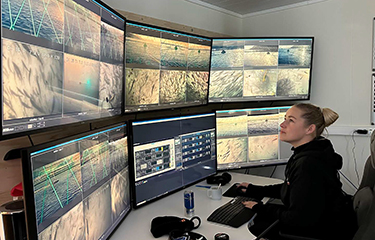In its interim results report for Q3 2023, Ice Fish Farm reported steep revenue and harvest drops compared to 2022, but a similarly big increase in operational earnings.
The Seltjarnarnes, Iceland-based salmon-farming company harvested just 193 metric tons (MT) of salmon in the quarter, a big drop from the 1,946 MT it harvested in Q3 2022. It was forced to cull salmon last summer after an infectious salmon anemia (ISA) outbreak, and only resumed harvests in September, the company said.
That fall in harvested volumes coincided with a drop in revenue to NOK 23.7 million (USD 2.2 million, EUR 2 million) from NOK 178.5 million (USD 16.7 million, EUR 15.2 million) in Q3 2023, and a drop in operational earnings before interest and taxes (EBIT) from NOK 13.6 million (USD 1.2 million, EUR 1.1 million) to NOK 3.5 million (USD 327,000, EUR 299,000).
However, the group’s earnings before interest and tax (EBIT) per kilogram of salmon sold reached NOK 18.20 (USD 1.70, EUR 1.55) per kilogram, over double the NOK 7.00 (USD 0.65, EUR 0.59) it earned in Q3 2022.
Ice Fish Farm's improved operating EBIT was not enough to offset its loss in revenue, however. The company posted a Q3 2023 loss before tax of NOK 14.4 million (USD 1.3 million, EUR 1.2 million), compared to a profit of NOK 110 million (USD 10.3 million, EUR 9.4 million) in Q3 2022.
For the year, the company’s profits improved, though it is still losing money. It has lost NOK 44.8 million (USD 4.2 million, EUR 3.8 million) so far in 2023, compared to the loss of NOK 53.6 million (USD 5 million, EUR 4.6 million) in 2022.
Ice Fish Farm said it produced 2,500 MT of biomass in September, a company record, and for the quarter it increased its biomass by 6,572 MT – a 76 percent increase. At the end of the quarter, Ice Fish Farm said it had 10.2 million fish in the sea, or 15,200 MT of total biomass, compared to 6,500 MT of biomass at the end of Q2 2023.
The company said it plans to move 1,500 MT of its harvests from Q4 2023 to Q1 2024 to achieve higher prices and optimize its production. The company said its harvest guidance for 2024 will now be 21,500 MT.
Ice Fish Farm also said that its smolt transfer has seen huge improvements in 2023, with 50 percent lower mortality rates compared to 2022. The smolt transfer reached 5.4 million fish with an average size above 300 grams.
“This is a result of the improved quality of the smolt and careful adjustments to how we handle the fish from the tanks to the wellboat. Good utilization of wellboat[s] have reduced cost on smolt transfer,” Ice Fish Farm said.
The company also said it’s planning to build a new freshwater station near its post-smolt station to create an all-in-one facility that will allow it to have a hatchery for eggs, initial feeding, and grow-out, as well as vaccination.
“With updates and investments in smolt stations we aim to produce about 7 to 8 million 400-gram average-size smolt split into spring and autumn,” Ice Fish Farm said. “This will increase utilization of sites in sea, reduce time in sea and lower risk.”
Ice Fish Farm said its long-term goal is to grow its smolt to larger sizes before putting them in sea cages, to shorten the time the fish spend in the cages.
“This will increase utilization of sites in sea and reduce time in sea and lower risk,” Ice Fish Farm said.
Ice Fish Farm is owned by Froya, Norway-based Måsøval. It completed the acquisition of Icelandic salmon-farming firm Laxar in June 2022.
Photo courtesy of Ice Fish Farm







